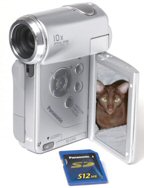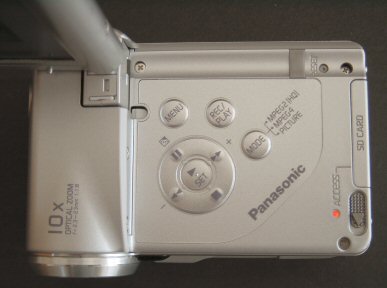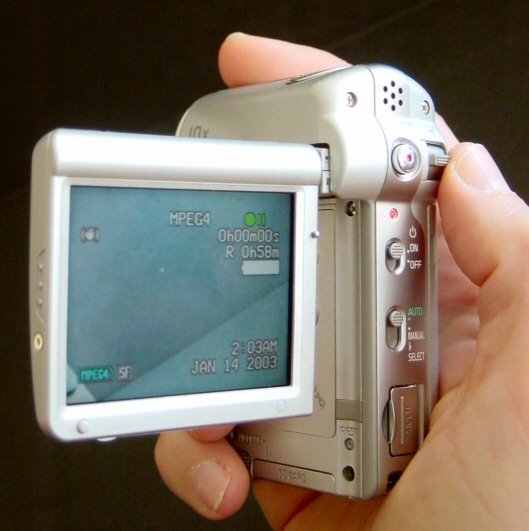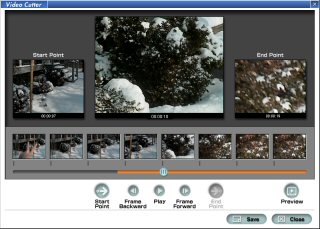|
|
|
Manifest Technology Blog
-- Site:
| Articles
| Galleries
| Resources
| DVI Tech
| About
| Site Map
|
Articles:
| PC Video
| Web Media
| DVD & CD
| Portable Media
| Digital Imaging
| Wireless Media
| Home Media
| Tech & Society
|
PC Video: |
PC Video Articles |
Video Software Gallery |
Video Editing Resources |
Panasonic D-snap SV-AV10 SD Video Camera
(5/2004)
- MPEG-2 and MPEG-4 video
- SD (Secure Digital) memory cards
by Douglas Dixon
SD Small
Shooting with the SV-100
SV-100 Formats
MediaStage Software
D-snap Wrap
References
How small can video camcorders go? Moving from the 8mm tape cassette to the
smaller DV tape size allowed camcorders to shrink down to around the size of a
thick (but heavy) paperback book. Not small enough? OK, well then Sony
introduced the matchbox-sized MICROMV cassette,
permitting the camcorder to shrink even further, dropping under a pound to a
size small enough to carry in an outer coat pocket. While you could imagine new
products with even smaller tapes, any tape-based camcorder will require all
those delicate spinning mechanical parts for the tape transport, which increases
the size and cost, as well as the risk of something breaking. Another option
that is being tried in recent products is to record to DVD disc, but
accommodating even the half-size mini-DVD disc results in a more bulky camcorder
design.
A better answer is to abandon all forms of winding or spinning media, and
move to solid state -- the same kinds of memory cards that are now ubiquitous
with digital cameras. By getting rid of all the mechanical parts for the tape
transport, you can totally demolish the size barrier, and design products like
the new Panasonic D-snap SV-AV100 SD video camera -- a literally
palm-sized camera that weighs about a third of a pound. At this size, it indeed
fits in a shirt pocket, and you're now comparing the form factor of a video
camera to a bar of soap!


The AV100 is one of two "D-snap" products from Panasonic (www.panasonic.com/d-snap),
introduced in September 2003, that set new benchmarks in miniaturization using SD
(Secure Digital) memory cards (www.panasonic.com/sd).
The D-snap family also includes a digital camera, the SV-AS10, shrunk to a size
of 2 x 4 x 1/2 inch, and weighing around 2 ounces. It shoots 2-megapixel stills,
plus Motion-JPEG video, and also can be used as a music player and voice
recorder. The AS10 digital camera has a list price of $299, and the AV100 video
camera we're discussing here lists at $999.
The advantage of using solid state storage for video cameras is that you can
get rid of all the clunky mechanical components of a tape-based camcorder,
greatly simplifying the design and therefore significantly reducing the size. At
this point, the limiting factors in the design become the lens, view screen, and
battery. The other limitation, of course, is usability -- the danger of
shrinking the unit and controls so much that you can't hold it comfortably or
steady, and can't find or press the buttons reliably.
The disadvantage of solid-state camcorders is that these tiny memory cards --
with form factors like a thick postage stamp or a small stick of gum -- cannot
store anything like the amount of data that you can spool onto a one-hour DV
tape, and are hugely more expensive. For example, DV video requires 25 Mbits/sec,
or 11 GB per hour. Even more compressed MPEG-2 video at 6 Mbits/sec requires 2.6
GB per hour of storage. Today's commonly-available memory cards store up to 512
MB (SD) or 1 GB (Memory Stick PRO), at prices around $350 to $600, respectively.
That's $600 to hold less than one-tenth of the capacity of a DV tape. Ouch!
Put that way, why are we talking about solid-state camcorders at all? While
they clearly are not going to replace DV for high-quality extended recording,
there still is a place for a much lighter and more portable camcorder that you
can use for capturing shorter clips. And memory card capacities continue to
double and redouble, and prices continue to drop, so this approach will only get
better over time.
For such a small and light camcorder, the SV-100 is quite effectively
designed for handling by clumsy human fingers. All the external connectors --
power, USB, AV in/out -- are out of the way on the front of the unit, protected
by plastic covers, and the SD card is under a flap on the bottom. The AV jack
supports playback to TV, recording from A/V input, and audio out to earphones.
The largest elements are on the sides: the flat battery on one side, and the
fold-out 2 1/2 inch LCD display on the other side (there's no viewfinder).
 External connectors
External connectors
The SV-100's playback and menu controls are simplified to a few buttons,
placed on the side under the LCD. There's a dedicated button for switching
between Record and Playback modes, a button for cycling between the recording
modes (MPEG-2, MPEG-4, and still Picture), and a third button for accessing the
menu display on the LCD. Then the SV-100 uses a four-position Multi-function
button for playback and menu selection controls: press the center to Play or
Set, or the four compass points to rewind / forward / pause / stop, or to
navigate the menus. All quite accessible and intuitive.
 Play Controls
Play Controls
The SV-100 menus provide access to a wide range of recording features,
including digital zoom, backlight compensation, white balance, program auto
exposure, manual exposure, manual focus, digital electronic image stabilization,
and even wind noise reduction. While you need to go into the menus to select
most of these modes, the current settings are shown as indicators over the video
on the LCD display.
To shoot with the SV-100, flip the LCD so that it faces the back of the unit.
Again, the few key buttons you need for the task are positioned on the back of
the unit: Power On/Off, Record Start/Stop, Zoom In/Out, and Auto/Manual
Focus/White Balance. To adjust the focus or white balance, toggle the Manual
slider to select Focus or White Balance on the LCD, and then use the
Multi-function button to adjust the setting. You also can use the Multi-function
button to toggle backlight compensation.
 Rear controls
Rear controls
So now it's a matter of figuring out how to hold the unit. You can rest it in
your right palm, and your fingers wrap naturally around the front under the lens
ring (but also covering the Recording Lamp red light that indicates you are
recording). I found that in order to position the thumb on the Record and Zoom
controls, it was best to twist the unit diagonally in my hand, so the thumb lies
along the back of the unit and the index finger actually goes over the top. This
allows you to hold and control the camcorder with one hand, and use the end of
the thumb to slide between the Record and Zoom controls. Otherwise, you'll find
you need to reposition your fingers to hit the Record button, so each recording
will begin and end with some shaking around as you adjust your hold.

The other issue with such a small and light camcorder, of course, is
shakiness as you shoot. It's just hard to brace a bar of soap and hold it
steady. You can use your other hand to hold the other side of the unit, or I
found that holding the folded-out LCD display with the thumb and index finger of
my left hand helped me to both steady and frame the shot.
For a small camera and lens, the SV-100 does have an impressive 10:1 optical
zoom to get in rather close, to approximately 1 3/8-inch. The lens is F1.8-2.3,
with a focal length of 2.3-23.0 mm, delivering light to a 1/6 inch CCD image
sensor. The next issue, then, is how the light is stored and compressed on the
memory card.
Providing reasonable recording times for a camcorder requires the same
approach used for digital cameras: compressing the digital data efficiently, and
offering choices to trade off the amount and quality of the recorded material --
in this case adjusting the compression formats, resolutions, and capture rates.
The SV-100 provides recording times of 10 to 20 minutes for almost full-screen
MPEG-2 on the included 512 MB SD card, and extended times of 1 to 10 hours using
MPEG-4 video format at lower res and lower rates.
The higher-quality compression format used by the SV-100 is MPEG-2,
the same compression approach used for DVD and much of cable and satellite
television. It records in "Fine" mode at 704 x 480 resolution,
and "Normal" mode at 352 x 480 resolution, which can fit about
10 or 20 minutes respectively on a 512 MB SD card. These compress the video at
approximately 6 and 3 Mbps, at constant bit rate, so in "Fine"
mode you're getting less horizontal resolution than normal NTSC DVD (740 x 480),
compressed in the camcorder hardware somewhat more aggressively than a typical
DVD (6 to 8 Mbps, but with variable bit rate, and often with multi-pass
compression). As a result, all else being equal, you should not expect this
compressed video to look as good as DV, or even DV converted to MPEG.
The SV-100 also offers the MPEG-4 compression format for longer
recordings. The MPEG-4 format was designed to accommodate a broader range of
uses than MPEG-2, from streaming video up to digital cinema, and down to
hand-held PDAs and wireless phones. The SV-100 offers four MPEG-4 modes,
"Fine" 320 x 240 resolution at 15 and 12 frames per
second, and "Normal" 176 x 144 resolution at 12 and 6 fps.
These use compression rates of 1 Mbps, and 420, 300, and 100 Kbps,
respectively, providing recording times of 1 hour, 2:20, 3:30, and up to 10:10
on a 512 MB SD card.
For audio recording, the SV-100 uses standard MPEG audio with MPEG-2
video (MPEG-1 Layer 2), and G.726 with MPEG-4.
The SV-100 also offers still recording modes, 640 x 480 JPEG compression,
storing up to 3520 pictures in "Fine" mode, and 7040 in
"Normal" mode on a 512 MB SD card.
Once you've shot video on the SV-100, there still remains the question of how
to get it back out, and what you can then do with it. You can use the A/V output
to play analog video out to a TV or VCR. You also can remove the SD card and
insert it in another device with a SD slot, to display photos or maybe the
videos on a compatible device with a SD slot, such as a TV, VCR / DVD player, or
portable multi AV player.
You also can use the included USB cable to access and transfer the clips to a
personal computer (there's no FireWire). The included software requires Windows
98SE or later, and includes a USB driver and the MediaStage viewing application.
The USB driver mounts the SV-100 and its memory card as a virtual device under
Windows (as with a digital camera), so you can directly access the files
recorded on the card from Windows Explorer. You then can copy the files from the
SD card to hard disk (and then burn the data files to CD or DVD as backups).
Each of the three media types is stored in a different directory on the card:
still images (.JPG), MPEG-2 video (.MOD), and MPEG-4 video (.ASF). All of these
files then can be played directly under Windows (though you do need to rename
the MPEG-2 files from .MOD to .MPG).
You also can use the included MediaStage software to access and view
the contents of the SD card. However, MediaStage is very basic: You can preview
the clips captured on the SD card, copy to the hard disk, do simple trims to
remove the beginning or ends of clips (typically because they are shaky), and
create playlists by assembling a sequence of clips.
 MediaStage: View SD
MediaStage: View SD
You can store the results back on the SD card, or export clips, but only in
MPEG-4 and Windows Media (WMV) formats. The interface also is overly
"friendly," for example, hiding the directory where the files are
being stored on the hard disk.
 MediaStage: Trim
MediaStage: Trim
If you really want to edit the resulting clips, things get trickier. Even the
higher-resolution MPEG format is not full-width, so will need to be stretched to
match DV or DVD resolution. In addition, many video tools do not work well with
native MPEG-2 format, and especially not MPEG-4. As a result, you'll probably
need to up-convert your MPEG videos to standard AVI or DV formats before you
edit them. You really only can use the lower-resolution and lower-rate MPEG-4
clips for streaming or video in a window.
The Panasonic D-snap SV-AV100 SD video camera clearly breaks new ground in
fitting a camcorder into a shirt-pocket form factor. It's a great solution for
capturing quick, short clips, especially because its portable size means it's
more likely that you will have it along with you in the first place.
Because of the limitations of the SD memory size, you do need to be conscious
of the trade-offs with the video resolution and quality. After up-converting to
edit with other footage, even the "Fine" quality MPEG-2 clips will be
visibly lower quality. But the other formats should work well for streaming and
other computer applications of video in a window. Pretty impressive for a bar of
soap!
Panasonic - D-snap Products / SV-AV100
www.panasonic.com/d-snap
Panasonic - SD Technology
www.panasonic.com/sd
|
